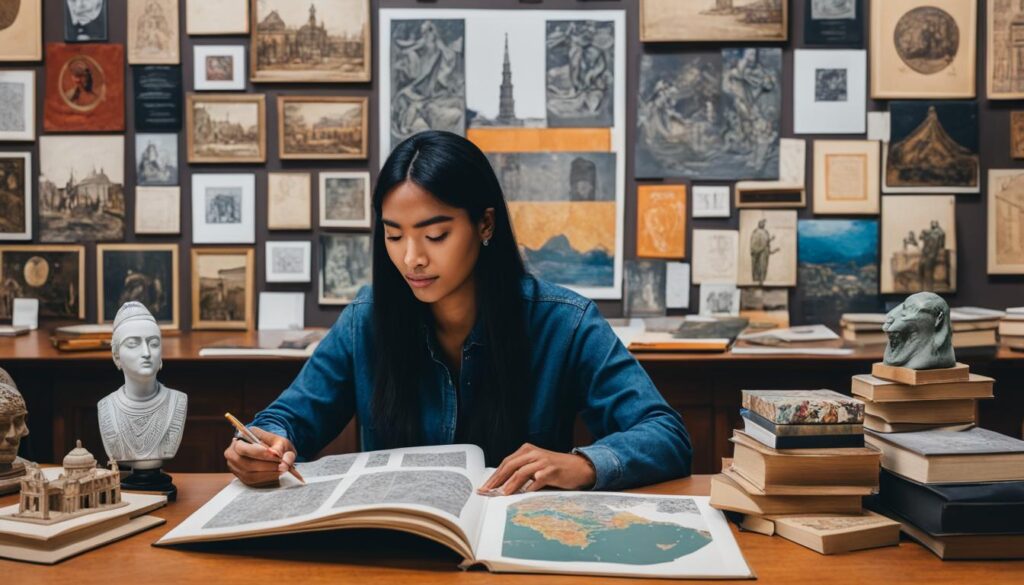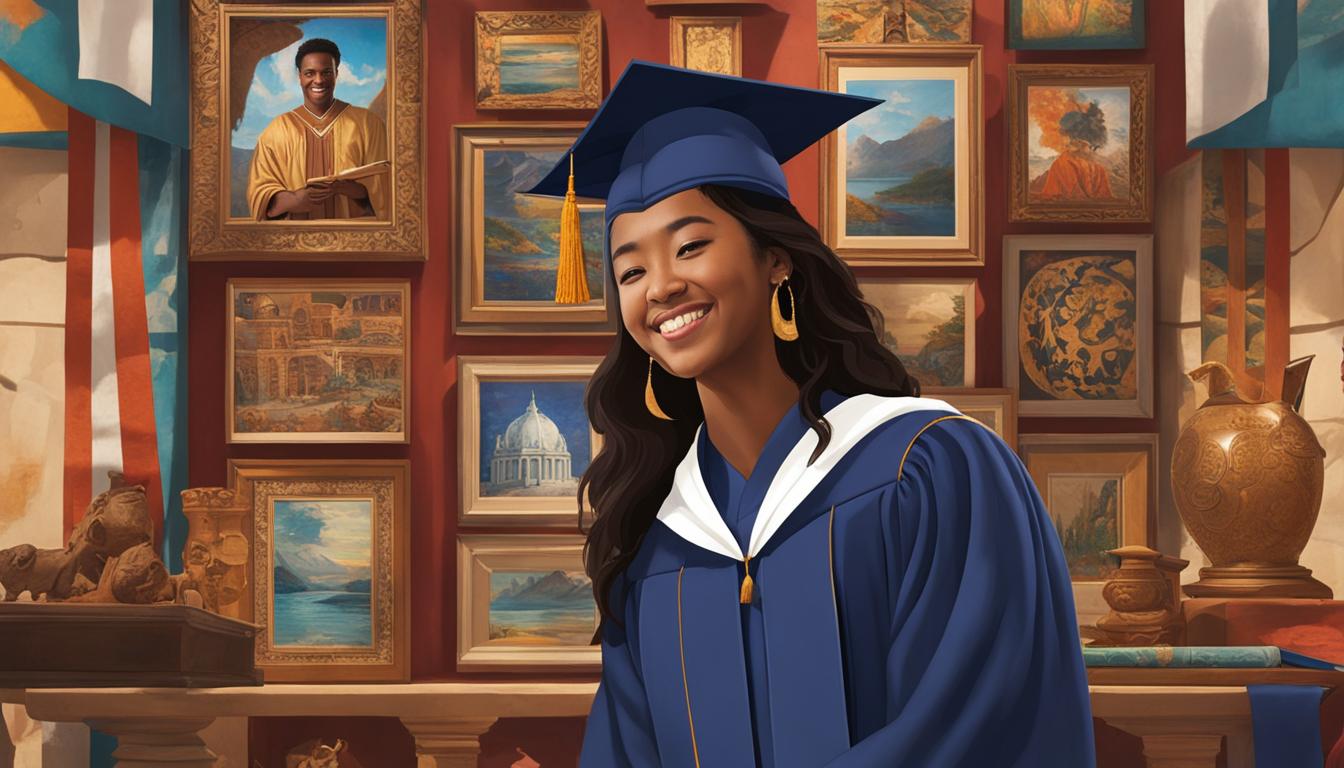If you’re intrigued by the evolution of cultural expressions and the role of art throughout history, pursuing a Bachelor of Arts in Art and Cultural History may be your next academic venture. This undergraduate degree in art and cultural history is far from a simple recapitulation of artists and their works. Instead, it offers a profound exploration of the values, inspirations, and societal currents represented in art from diverse eras and locations. Consider this degree a key to unlocking a greater understanding of how cultures have communicated their identities through visual means—perhaps it’s the key you’ve been looking for.
As a cultural history major, you’ll engage with a spectrum of subjects that cross temporal and geographical boundaries. Whether they are sculptures carved in ancient times or digital pieces designed in the contemporary world, each piece you encounter will contribute to your holistic comprehension of cultural history and its art forms. Such knowledge equips you with coveted critical thinking abilities and a sharp eye for detail, vital tools in many professional arenas.
Key Takeaways
- Embarking on a cultural journey through an undergraduate degree in art and cultural history.
- Developing a nuanced understanding of cultural narratives via visual arts.
- Acknowledging the extensive scope of study, from ancient artifacts to contemporary art.
- Acquiring key skills in critical thinking and visual analysis beneficial in various careers.
- The interdisciplinary nature of a cultural history major, blending archaeology, sociology, and more.
- Preparation for roles in education, museum curation, and cultural conservation with this degree.
Discovering the Bachelor of Arts in Art and Cultural History
When you embark on the journey of obtaining a Bachelor of Arts in Art and Cultural History, you are not merely studying the history of art and culture; you are embarking on a quest to unravel how societies express their identities, struggles, and innovations through the language of creativity. This degree is a tapestry woven with diverse threads of human expression and a reflection of the world’s multitude of beliefs and aspirations.
Understanding Art History as a Reflective Mirror of Societal Values
Art tells the story of who we are. By delving into art and cultural history, you decode the narrative of civilizations, observing how every stroke, shape, and hue illustrates our collective past. An Art and Cultural History degree encourages you to see beyond the canvas, exploring the economic, political, and social climates that shape each masterpiece you study.
Breadth of Study: From Ancient to Contemporary Art Efforts
The span of artistic endeavors you encounter within this degree surpasses time and borders. As you toggle between the amphitheaters of ancient Greece and the spray-painted walls of modern cityscapes, you not only track the evolution of art forms but also engage with the essence of human progress and the perpetual dialogues sparked by artists of every era.
Skills Gained from an Art and Cultural History Degree
Through an intricate combination of visual analysis, critical thinking, and interdisciplinary connections, your skill set expands vastly. The table below reveals the top competencies imparted by a Bachelor of Arts in Art and Cultural History, and their real-world applications:
| Skill | Description | Real-World Application |
|---|---|---|
| Visual Literacy | Ability to interpret and communicate ideas through images | Museum curation, art criticism, educational outreach |
| Critical Thinking | Analyzing and evaluating art within cultural and historical contexts | Gallery management, academic research, cultural policy development |
| Communication Skills | Articulating and presenting complex concepts both orally and in writing | Public relations for arts organizations, publishing, art therapy |
| Research Acumen | Conducting thorough investigations into art history topics | Archival work, historic preservation, documentary production |
As you continue on your academic path, always consider how the skills and insights gathered from your Art and Cultural History degree prepare you to become a curator of humanity’s visual heritage. Your role extends far beyond academics; you become a steward of culture and an interpreter of the visual stories that define our existence.
Exploring Career Paths with a BA in Art and Cultural History
Choosing to pursue a Bachelor of Arts in Art and Cultural History is not only a commitment to understanding the richness of artistic traditions but also a gateway to diverse career opportunities. Whether you have a passion for architectural marvels or a dedication to preserving our cultural heritage, this degree serves as a crucial stepping stone towards a fulfilling professional life in these sectors. Below, we explore the potential careers this degree can lead to and the professional competencies it fosters.
Career Options Across the Spectrum of Art and Culture
Graduates with a Bachelor of Arts in Art and Cultural History are well-prepared to embark on various career paths. You may find yourself contributing to the education sector, especially within K-12 arts education, inspiring the next generation with your knowledge of cultural history. Museums, often seen as the bastions of culture and art, offer creative roles that may align perfectly with your skill set. Architectural firms also value individuals who bring a nuanced understanding of historical contexts to their projects, expanding careers in architecture beyond traditional paths.
Professional Preparation: From Art Administration to Conservation
Your comprehensive cultural history courses have prepared you for intricate roles that demand a sharp eye and attention to detail, such as art conservation. Conservation professionals play a pivotal role in preserving the integrity of our cultural artifacts for future generations. Similarly, art administration positions within governmental or private sectors require the kind of cross-disciplinary expertise that a degree in Art and Cultural History provides, enabling cultural institutions to thrive.
- Art Education: Instructing and developing curriculum based on artistic historical context
- Arts Administration: Managing programs, overseeing operations, and leading cultural initiatives
- Museum Curation and Exhibition Design: Organizing exhibitions and managing collections
- Architectural Consultancy: Offering advice on historical styles and preservation
- Art Conservation: Restoring and conserving art works and historical buildings
Educational Journey: Coursework and Degree Requirements
Embarking on an Art and Cultural History degree is not just an academic commitment but a voyage through time and creativity. You’ll immerse yourself in a curriculum that’s as broad and diverse as the subject it explores. Each course has been carefully woven into the program to ensure a comprehensive understanding of not just art, but its infinite connections with cultural narratives throughout history.
Starting with foundational surveys, you’ll traverse the expansive landscapes of human expression and its relevacies to societal transformations. As you progress, you’ll delve into cultural history courses that challenge you to consider the context and impact of art across various periods and regions, effectively bridging the past with the contemporary world.
The art history program isn’t limited to the confines of dates and artists; it’s an interdisciplinary endeavor that melds elements from history, sociology, and even anthropology to cultivate an intricate tapestry of human culture. Mandatory history courses are integral, providing you with the analytical tools to dissect and interpret the language of art.
- Foundational Art and Cultural Surveys
- Advanced Electives in Global Artistic Periods
- Cross-disciplinary Historical Studies
- Senior Methods Colloquium – Capstone Experience
Through this program, you don’t just study art; you live through its stories, understanding its power and role through ages, and emerge prepared to contribute to its ongoing dialogue.
In the capstone of your degree—the Senior Methods Colloquium—you’ll harness your cumulative learning to engage in profound research, leveraging methodologies and presentation skills that are crucial for any aspiring art historian’s toolset. This experiential component ensures your educational journey equips you with professional prowess that transforms passion into opportunity.
Your degree doesn’t just signify completion; it’s a mosaic of experiences, perspectives, and skills that will influence your path in the vast world of arts and culture. So, take this step with confidence, knowing every course is a building block towards a rich professional life enriched by the timeless dialogue of art and culture.
Exclusive Insights into the Art History Program at Queens College
If you’re contemplating a bachelor’s degree in art and culture, Queens College shines with its dynamic Art and Cultural History degree program. Not only will you immerse yourself in a curriculum steeped in diverse chronological narratives, but you will also engage with art from across the globe, fostering a deep understanding of visual culture through multiple lenses.

Global Art Exposure within the Curriculum
The hallmark of the art history program at Queens College is its commitment to offering a panoramic view of world art traditions. Students participate in an interdisciplinary exploration that includes:
- Mesopotamian clay tablets
- Renaissance paintings and architecture
- Contemporary digital media practices
Through this extensive curriculum, your appreciation and critical analysis of different cultures are enhanced, preparing you to contribute insightfully to discussions on international art discourse.
Capstone Experiences: Senior Methods Colloquium
As the crescendo of the Art and Cultural History degree, the Senior Methods Colloquium is a transformative experience that will test and refine your research methodologies and presentation capabilities. This culminating project includes:
- Intensive theoretical research assignments
- Development of thesis-driven analytical papers
- Oral presentations that synthesize your academic journey
This rigorous capstone ensures you’re not just graduating with a surface-level understanding but with a genuine mastery of the principles and practices that define the rich tapestry of global art history.
Bachelor of Art and Cultural History (BA in Art and Cultural History)
Embarking on a Bachelor of Arts in Art and Cultural History equips you with a unique blend of skills tailored for a dynamic job market. This specialized art history program integrates an array of disciplines, preparing you to interpret and analyze the complex web of cultural narratives that shape our understanding of history and art.
Career-Ready Skills for the Evolving Job Market
The cultural history major carves a path for students seeking careers that value analytical prowess and adaptability. Rarely has the need for professionals who can critically navigate cultural trends and art movements been so pronounced. Your academic journey will fine-tune your ability to engage with historical contexts and apply this insight to contemporary cultural phenomena.
Multidisciplinary Approaches in Art History Education
Beyond the conventional boundaries of art education, the art history program at renowned institutions like Queens College fosters a multidisciplinary approach. Dive into courses that run the gamut from traditional art historical methods to digital curation, enriching your expertise for a career at the forefront of education, gallery management, or heritage conservation.
| Core Skill | Application in the Job Market | Related Course Types |
|---|---|---|
| Visual Analysis | Museum curation, art appraisal | Art Theory, Renaissance to Modern Art |
| Critical Thinking | Academic research, cultural policy development | Critical Methods in Art History, Cultural Studies |
| Interdisciplinary Research | Education, conservation work | Antiquity in the Modern World, Digital Humanities |
| Communication Skills | Editorial positions, public relations in art | Art Criticism, Communication in Art |
Conclusion
The journey through the Bachelor of Art and Cultural History is more than an academic pursuit—it’s a voyage into the heart of society’s most profound visual narratives. Upon completing this undergraduate degree in art and cultural history, you will have traversed through epochs and empires, understanding how the brushstrokes and sculptural lines of the past continue to shape the contours of our current cultural landscape. This comprehensive degree equips you with the tools to decode and contribute to the cultural conversation, affirmed by history’s whisper echoing in contemporary creations.
Whether your interest lies in critiquing the canons of classical art, contributing to the vibrant discussions in modern galleries, or curating experiences that bridge communities with their heritage, the skills and insights derived from cultural history courses are indispensable. This degree hones your ability to critically analyze, communicate, and weave together disparate threads of historical context, setting you on a path to influence a society’s cultural comprehension and appreciation.
As the curtains draw on your undergraduate odyssey, remember that the knowledge and skill sets you have cultivated are your passport to a world where art and history intersect. Through the exploration of this interdisciplinary field, you’re poised to harness the transformative power of art and cultural history, enriching not just your own life but also enhancing the cultural fabric of the communities you will touch. Embrace your role as a custodian of humanity’s visual heritage and a storyteller for generations to come.
FAQ
What is a Bachelor of Arts in Art and Cultural History?
A Bachelor of Arts in Art and Cultural History is an undergraduate degree that explores the development of art and visual culture within their historical and societal contexts. The program encompasses a study of diverse cultural periods and regions, examining the influences and significances of visual art, from antiquity to the modern era.
What skills can I expect to gain from an Art and Cultural History degree?
You will develop critical thinking, visual analysis, research methodologies, and communication skills. The program encourages interpreting art within its cultural narrative, preparing you for diverse professional roles in the arts and cultural sectors.
What career opportunities are available with a BA in Art and Cultural History?
Graduates can pursue careers in K-12 arts education, museum and gallery curation, arts administration, art conservation, historic preservation, and many other sectors where understanding of art and culture is essential. The skills acquired are also applicable to roles in design firms, cultural institutions, and government organizations involved in cultural projects.
What types of courses are included in the Art and Cultural History program?
The curriculum typically includes foundational art history surveys, advanced electives focused on specific periods or regions of art, interdisciplinary courses in the humanities, and capstone experiences that involve research and presentation in the field of art history.
How does Queens College approach the Art and Cultural History degree?
Queens College offers a unique approach that emphasizes a broad historical scope and global art exposure. Their curriculum includes comprehensive study across various timeframes and regions, supplemented by a rich Senior Methods Colloquium as a capstone experience to prepare students for professional success.
Why is multidisciplinary learning important in an Art and Cultural History degree?
Multidisciplinary learning broadens your understanding by integrating perspectives from related fields such as anthropology and sociology. This approach enriches your comprehension of cultural history and enhances your ability to analyze art in its broader societal and historical context.
How does a BA in Art and Cultural History prepare me for the evolving job market?
The degree provides versatile skills in critical analysis and a deep understanding of cultural contexts, which are increasingly valuable in a job market that requires professionals to adapt and apply nuanced knowledge across various sectors including education, public and private cultural organizations, and creative industries.

